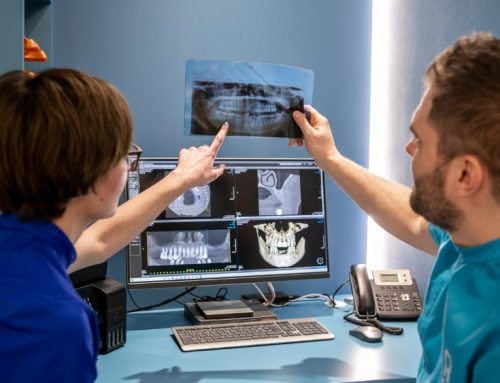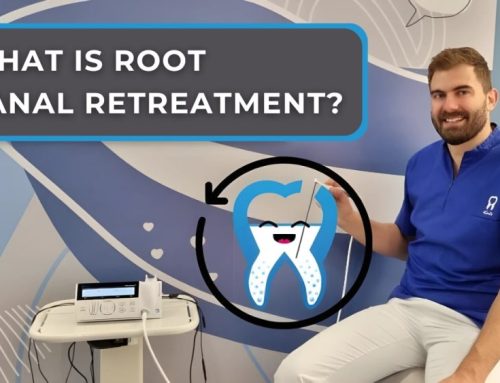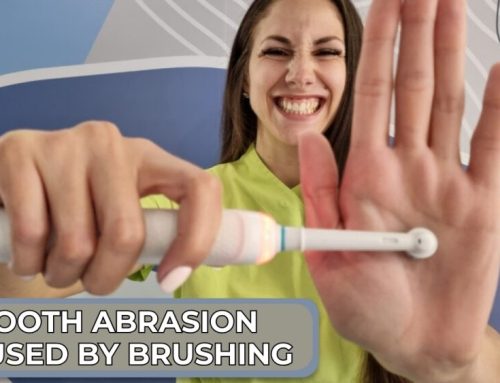To avoid finding yourself in a situation where you do not understand all the terms in professional terminology during a conversation with your dentist or while researching solutions for your own oral issues, Dental Center 4Smile in Europe, Croatia, has written a glossary “Dentistry from A to Z” which can help you understand dental names and expressions! Read on:
A
- ABRASION – tooth wear, the intensity of tooth wear can be influenced by bad habits (chewing on pencils and other objects), lack of molars, incorrect brushing technique, teeth grinding…
- ABSCESS – localized inflammation, accumulation of pus in bone or tissue caused by an infection
- ABUTMENT (SUPRASTUCTURE) – a part of titanium structure that is fixed into the dental implant after osseointegration and serves to connect a prosthetic replacement (dental crown, dental bridge or similar) with a titanium screw
- ALVEOLOTOMY – removal of wisdom teeth
- AMALGAM – a material used to make silver fillings (“dark fillings”)
- ANESTHETIC – a substance that relieves pain
- ANTERIOR TEETH – front teeth
- APEX – The tip of the root of a tooth
- APICOECTOMY – a procedure that removes inflamed tissue around the tooth root, as well as the apex of the tooth root
- ALL ON 4 – a fixed bridge on 4 implants with immediate loading, a solution for edentulous jaws. Edentulous patients can receive a temporary prosthetic work fixed with screws within 24-72 hours
- ALL ON 6 – a fixed bridge on 6 dental implants with immediate loading, a solution for edentulous jaws. Edentulous patients can receive a temporary prosthetic work fixed with screws within 24-72 hours. It is a more stable version of the ALL ON 4 method, because the more implants we can place in a jaw, the more firm final work will be
B
- BILATERAL – both sides (left and right)
- BONDING – A dental procedure where a tooth-colored resin is applied to the tooth to correct imperfections or cavities
- BONE AUGMENTATION – in certain cases, artificial bone is placed in the extraction socket right after a tooth extraction to increase the potential volume of bone so a dental implant can be placed in that spot
- (DENTAL) BRIDGE – a prosthetic replacement made of at least two connected dental crowns
- BRUXISM – teeth grinding
C
- CALCULUS REMOVAL AND SANDBLASTING – Professional and painless treatment for maintaining teeth, gums and alveolar bone healthy
- CANINE – A pointed tooth located between the incisors and premolars, used for tearing food.
- CAVITY – an infectious disease of the hard tooth tissue, causing demineralization of the tooth
- CARIOGENIC – anything that causes cavities
- CBCT – 3D imaging of the jaw, necessary for determining bone volume as condition for placing dental implants
- CERAMIC CROWN ON METAL – dental crowns made of a metal base with ceramic layers applied
- CERAMIC CROWN ON ZIRCON – dental crowns made of a high-quality, strong zirconium base, coated with ceramic
- CIRCULAR BRIDGE – a ceramic bridge made of 12 ceramic crowns
- CLEFT LIP – a congenital deformity where one or more tissues of the lip fail to fuse
- CLEFT PALATE – a congenital deformity resulting in the failure of the soft and hard palate to fuse, either partially or completely
- COMPOSITE – A tooth-colored material used for fillings, bonding, and veneers.
- COMPOSITE FILLING – dental material (filling) that replaces a portion of the tooth lost to decay
- COMPOSITE POST – a glass composite pin placed in the root of the tooth to replace the crown of the tooth
- COSMETIC DENTISTRY – any dental treatment aimed at improving the appearance of the mouth and teeth, with the goal of achieving a beautiful smile – a satisfied patient
- CROWN – an artificial tooth cap that fits over an existing tooth after it has been reshaped
- CROWN CEMENTATION – definitive fixation of a dental crown
D
- DECAY – The process by which a tooth breaks down due to bacterial activity, leading to cavities
- DENTAL SPECIALIST – a doctor who has completed a specialist degree in one of the dental fields
- DENTIN – The tissue beneath the enamel that forms the bulk of the tooth.
- DENTIST – A healthcare professional specializing in the diagnosis, prevention, and treatment of dental conditions.
- DENTURE BASE – part of the denture that helps stabilize it in the mouth, resting on soft tissues (gums, palate, and edentulous ridge), and holds the teeth that replace the missing ones
- DENTURE – an artificial replacement for one (rarely) or more teeth
- DENTURE ON A BAR – a semi-fixed prosthetic work on 4 implants, connected with a Wironit denture through individually made bars
- DENTURE ON LOCATORS – a semi-fixed prosthetic solution for edentulous jaws, where the Vironit denture is fixed to implanted locators or ball attachments
E
- ENAMEL – hard, calcified tissue that covers the dentin of a tooth crown, the hardest tissue in the human body
- ENDODONTICS – a microsurgical procedure in the root canals of teeth aimed at preventing the spread of infection from the oral cavity through the tooth canal to the root and surrounding bone tissue
- EROSION – wear of tooth structure caused by acids
- EXTRACTION – The removal of a tooth from its socket in the bone
F
- FILLING – the replacement of a lost part of a tooth with various materials
- FIXED PROSTHESIS – a prosthetic work that is cemented to teeth or dental implants
- FIXED SCREW-RETAINED DENTAL BRIDGE – a prosthetic work on 6-8 implants that is not cemented but is fixed to the implants with screws, and can be removed during check-ups in the dental office
- FLUORIDE – A mineral that helps prevent tooth decay and strengthens enamel.
- FRACTURE – a break in part of the bone or tooth
- FRENULUM – A small fold of tissue that holds down a part of the body, such as under the tongue or between the upper lip and gum
- FULL (COMPLETE) DENTURE – an artificial replacement for all teeth in the jaw
G
- GENERAL DENTISTRY – the branch of dentistry that deals with treating teeth damaged by cavities or trauma
- GINGIVA – (gums) soft tissue around the tooth crown neck, also known as the gum tissue
- GINGIVA FORMER – a screw (gingiva former) that shapes the gingiva (gum tissue) according to the future dental crown
- GINGIVAL SULCUS – the space between the gingiva and the tooth
- GINGIVITIS – inflammation of the gums
- GINGIVECTOMY – removal of part of the gingiva
- GINGIVOPLASTY – surgical procedure to shape the gingiva
- GRIND – To wear down or break apart teeth, often caused by bruxism
- GUM RECESSION – The process where the gums pull back from the teeth, exposing the roots and potentially leading to tooth sensitivity
H
- HALITOSIS – Bad breath
I
- IMMEDIATE IMPLANTATION – placing an implant immediately after tooth extraction
- IMMEDIATE LOADING – creating a prosthetic work immediately after implant placement
- IMPACTED TOOTH – a tooth that has not fully erupted or is partially exposed. Common reasons for this include other teeth that block eruption, bone, or soft tissue
- (DENTAL) IMPLANT – a titanium replacement for a lost tooth root, made from a biocompatible material (titanium), which fuses (osseointegrates) with the surrounding bone
- IMPLANT–PROSTHETIC THERAPY – therapy that involves placing dental implants and installing prosthetic work (ceramic dental crown, ceramic dental bridge, or denture)
- IMPLANTATION – the process of placing a dental implant
- INCISOR – A front tooth used for cutting food
- INLAY – a ceramic dental replacement used to restore the natural tooth crown when only the upper surface of the tooth is damaged
- INTERPROXIMAL – between the teeth
- INTRAORAL – inside the mouth
J
- JAWBONE – The bone structure that holds the teeth in place, including the upper (maxilla) and lower (mandible) jawbones.
L
- LESION – damage, wound, or diseased area of tissue
- LABIAL – the area toward the lips
M
- MALOCCLUSION – incorrect positioning of both jaws, including upper and lower teeth
- MAXILLA – upper jaw
- MANDIBLE – lower jaw
- MOLAR – A large tooth at the back of the mouth, used for grinding and chewing food
- MOUTHGUARD – a protective device used to prevent injuries to the teeth, mouth, and lips, most commonly used after orthodontic treatment, for bruxism, and in sports.
N
- NIGHT GUARD – A custom-made appliance worn at night to prevent teeth grinding and clenching.
- NERVE – The tissue inside the tooth that transmits sensations of pain and temperature; often treated during root canal therapy
O
- OCCLUSION – contact between the chewing surfaces of teeth in the upper and lower jaws during chewing and biting
- ONLAY – a ceramic dental filling that replaces tooth damage including individual cusps
- ORAL – anything related to the oral cavity
- ORAL MUCOSA – the pink tissue that covers the inside of the mouth
- ORAL SURGERY – a branch of dentistry that includes tooth extraction and treatments for other oral issues that require surgical intervention
- ORTHODONTICS – The branch of dentistry that deals with the diagnosis and correction of misaligned teeth and jaws
- ORTHODONTIST – a specialist who uses specific treatments to bring teeth and jaws into proper alignment
- ORTHOPANTOMOGRAM – X-RAY – is an X-ray image of both jaws and is used as a primary diagnostic tool for creating a treatment plan in dental medicine.
- OVERLAY – a ceramic dental filling used when there is significant damage to a tooth
P
- PALATE – hard and soft tissue that is located on the upper part of the oral cavity and separates the oral cavity from the nasal cavity
- PALLIATIVE – treatment that relieves pain but does not cure
- PAROTID GLANDS – the main salivary glands located below and in front of the ears
- PERIODONTIUM – the tissue around the tooth that also provides support
- PERIODONTAL ABSCESS – an infection in the pockets around the tooth that can destroy both soft and hard tissue
- PERIODONTAL DISEASES – inflammatory processes of the gums or periodontal ligament of the tooth that lead to the deepening of the gingival sulcus, which results in the formation of pockets and the loss of hard tissue (bone)
- PERIODONTAL POCKET – a deepened gingival sulcus
- PERIODONTITIS – Severe gum disease that affects the soft tissue and bone supporting the teeth, often leading to tooth loss if untreated
- PERIODONTOLOGIST – a specialist who treats diseases and conditions of the supporting tissues and tissues around the tooth
- PLAQUE – a soft, sticky substance that accumulates on teeth from food residues due to improper oral hygiene and is full of bacteria
- POSTERIOR – refers to the teeth and tissue located inside the oral cavity
- PRGF – is a plasma treatment that involves natural cell regeneration of the skin
- PROSTHETICS – a branch of dentistry that replaces lost teeth, aesthetically corrects existing ones, i.e., improves the function and appearance of teeth
- PROVISIONAL DENTURE – a temporary denture placed immediately after the removal of the remaining natural teeth
- PULP – the tissue (blood vessels and nerve endings) found in the root of the tooth
Q
- QUADRANT – One of the four sections of the mouth (upper right, upper left, lower right, lower left) used in dental charts and procedures
R
- RADIOLOGICAL ANALYSIS – imaging of teeth, surrounding bones, and sinuses. It is indispensable in modern dentistry
- RADIOVISOLOGRAPHY – RVG – a digital sensor that allows us to create an intraoral image without film
- RANULA – a cyst that develops under the tongue at the bottom of the oral cavity.
- RECESSION OF GUMS – a condition characterized by the loss of gum tissue due to infection or bone loss
- RELINING – replacement of the base of the denture
- RESORPTION – permanent loss of bone and tooth roots
- RESTORATION – The process of restoring a damaged or decayed tooth to its normal function and appearance
- RETAINER – A device used to maintain the position of teeth after orthodontic treatment
- ROOT CANAL – the space in the center of the root that contains pulp tissue with blood vessels and nerve endings
- ROOT CANAL TREATMENT – treatment for diseases or injuries of the pulp
S
- SALIVATION – secretion of saliva
- SANDBLASTING – cleaning teeth with sodium bicarbonate powder in a stream of water and air to remove plaque and staining from the teeth
- SCALING – The process of cleaning teeth to remove tartar and plaque buildup
- SEALANT – A protective coating applied to the surface of teeth, particularly molars, to prevent cavities
- SEALING OF FISSURES – applying material to the chewing surface of teeth to protect the enamel from the development of cavities, used in pediatric dentistry
- SEMI-FIXED DENTURE – a prosthetic work on fewer dental implants that can be removed as needed (dental prosthesis on a bar, denture on locators)
- SINUS LIFT – for patients who have been edentulous for a long time, the maxillary sinus is very close to the ridge, meaning there is insufficient bone height for dental implant placement. To achieve the necessary height for firm osseointegration, the sinus is lifted with artificial bone, PRGF, or parts of the patient’s own bone
T
- TARTAR – mineralized deposits that attach to the crown or root of the tooth, often caused by improper oral hygiene
- TEETH WHITENING – A professional cosmetic treatment to lighten the color of teeth by few shades
- TELESCOPIC CROWNS – a double dental crown consisting of an outer and an inner part, one of which is cemented onto the tooth stump, while the other is a component of the prosthesis
- TEMPOROMANDIBULAR JOINT (TMJ) – The joint connecting the jawbone to the skull, which can cause discomfort or pain in case of dysfunction
U
- ULCER – A painful sore or lesion that can form inside the mouth, often due to irritation, infection, or systemic conditions
V
- (DENTAL) VENEERS – thin pieces made of glass-ceramic, which has pronounced transparency and natural appearance. They can be used to change the shape, size, width, and color of teeth
- VITALITY – Refers to the health of the tooth’s pulp or nerve, indicating whether it is alive or dead.
W
- WIRONIT DENTURE – a partial Wironit denture that can replace lost teeth in the back part of the jaw, with special clasps that allow it to be attached to the front teeth unobtrusively
- WISDOM TEETH – the last teeth on both sides of the upper and lower jaw
X
- XEROSTOMY – dry mouth or decreased salivation (secretion of saliva)
Y
- YELLOWING – Discoloration of teeth that can occur due to aging, staining, or other factors
Z
- ZIRCONIA – A strong, durable material used for dental crowns, dental bridges, and other dental restorations, often favored for its aesthetic qualities














